There are many factors that can change education, such as advances in technology, changes in pedagogy, shifts in societal values and priorities, and changes in funding and policy.
Technology has had a significant impact on education in recent years. The widespread availability of high-speed internet and mobile devices has made it possible for students to access online resources and learning materials from anywhere. Online learning platforms and educational software can also be used to personalize instruction and provide real-time feedback to students.
Changes in pedagogy, or the methods and strategies used to teach, can also have a big impact on education. For example, the shift towards inquiry-based learning and project-based learning can help students develop critical thinking and problem-solving skills.
Societal changes can also influence education. For example, an increased focus on STEM education may be driven by a need for more workers with skills in science, technology, engineering, and mathematics. Similarly, changes in immigration policies can affect the demographics of the student population and the types of resources and support needed in schools.
Lastly, changes in funding and policy can have a big impact on education. For example, a reduction in funding for schools can lead to larger class sizes, fewer resources, and reduced access to extracurricular activities. On the other hand, an increase in funding can lead to improved facilities, more teacher training, and better educational programs.
How can an AR_Book affect education?
AR books, also known as augmented reality books, are a new technology that aims to revolutionize the way we learn and educate ourselves. These books make use of augmented reality technology to create an interactive and immersive reading experience for users. By incorporating this technology, AR books have the potential to change the way we approach education by:
• AR books can also provide additional information and context, allowing students to explore and learn more about a topic in depth.
• AR books can also provide opportunities for hands-on learning and experimentation, allowing students to experience concepts in a more tangible way.
• AR books can also be used to support different learning styles, catering to visual, auditory and kinesthetic learners.
• AR books can also be used to make learning more accessible for students with special needs, such as visual or hearing impairments, by providing audio and visual aids.
• AR books can also be used to support language learning, by providing translations and pronunciation guides.
• AR books can also be used to support remote learning, by providing students with access to interactive and engaging content from home.
In conclusion, the use of AR_Book in education can have a significant impact on the way students learn and engage with material. It can provide students with a more interactive and immersive experience, allowing them to visualize and interact with content in ways that traditional books cannot. Additionally, it can allow for more personalized and self-directed learning, as well as opportunities for collaboration and experimentation. As technology continues to advance, AR_Book and other forms of augmented reality have the potential to revolutionize the field of education and help students achieve their full potential.

